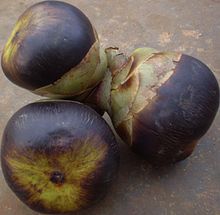Palmyra palm
| Palmyra palm | ||||||||||||
|---|---|---|---|---|---|---|---|---|---|---|---|---|

Three palmyra palms ( Borassus flabellifer ) in Angkor Wat . |
||||||||||||
| Systematics | ||||||||||||
|
||||||||||||
| Scientific name | ||||||||||||
| Borassus flabellifer | ||||||||||||
| L. |
The Palmyrapalme ( Borassus flabellifer ), also Lontarpalme or Lontaropalme , is one of the most common palm . It represents the sugar palm in the dry , tropical regions of southern India. Occurrence on both coasts of the Persian Gulf , on the Malabar coast to Gujarat and on the Indus , along the Coromandel coast to Chennai , on the Irrawaddy in rear India , in Malaya , the Sunda Islands and the Moluccas to Timor , forming entire forests here and there. Their occurrence extends approximately between 10 ° south and 30 ° north latitude and between 54 ° and 140 ° east longitude. In the mountains of Sri Lanka it thrives up to 770 m above sea level , but prefers sandy plains at sea level. Today it is grown in large areas of Asia and in tropical Africa .
description
The trunk reaches heights of up to 30 m, a diameter of 60 cm and tapers in a conical shape so that it is only 30 cm thick on the crown, which consists of a dozen fan-shaped leaves up to 3 m long. This species is dioecious separately sexed ( dioecious ); male and female inflorescences appear on two different plants. Mannability between the ages of 12 and 15. The fruits are similar to coconuts, but are slightly smaller and rounder and the size of a child's head.

use
The outer shell of the nut contains a spongy, juicy flesh when ripe , which tastes sweet and not unpleasant. In the soft mass lie three oblong, round nuts with a rock-hard shell and a bluish, gelatinous, edible core with a sweet taste. The unripe core contains a sweet, tasty milk juice . The Palmyra palm is partly planted next to the coconut palm in East India and represents this in some areas.
A sugar-rich juice ( toddy ) is obtained from the male inflorescences by wrapping, crushing and daily cutting off a thin slice for months , which is processed into palm sugar or palm wine . The ripe fruits are eaten either raw or roasted, or used in cakes. The black, rock-hard wood is used for carpentry and turning work, but especially as very durable construction timber. The leaves are used for fencing and roofing. It is also used to make mats, sacks, baskets, fans, hats and umbrellas.
Young plants are a popular food in Sri Lanka and are cultivated for this purpose. Dried and ground, they make a valuable flour. Sago is obtained from the root pulp . In Europe, the palmyra palm is often found in greenhouses. The species is also traded as an ornamental plant.
The leaves of the palmyra palm were previously used in South and Southeast Asia as writing material for palm leaf manuscripts .
A fiber can be obtained from the palm that is traded under the name Bassine .
literature
- W. Franke: Crop science. Thieme, Stuttgart-New York, 1997, ISBN 978-3-13-530406-9 .
- Meyers Konversations-Lexikon . 4th edition, 1889.
Individual evidence
- ↑ NIIR Board of Consultants & Engineers: Natural Fibers Handbook With Cultivation & Uses. ISBN 81-86623-98-1 , p. 493.

